- Idi di Marzo, Montepulciano d’Abruzzo , N.V. $16
- Ch Les Graves de Viaud Cuvee Prestige 2019, $23
- Semeli Winery 2021 Mantinia Moschofilero, Greece $19
- Alleno-Charpoutier CdR, $20
- Domaine Lavau Rasteau 2019. $21
- Due Terre Catarratto. $20
———————– (The 3-bottle Club Option) ———————–
1. Idi di Marzo, Montepulciano d’Abruzzo , N.V. $16
The Wine
Idi di Marzo translates as the “Ides of March”. Though in this case, there is nothing of which to beware! This is an absolutely delicious wine and a shining example of the value coming out of Spain and Italy (in this case).
Abruzzo is one of 20 regions in Italy, a region being a geographic / governmental designation with similarities to both our states and counties. Located South of the Marche region and Northeast of Rome, this is the northern dividing line of central/southern Italy, with Abruzzo enjoying coastal views looking Eastward into the Adriatic. This seaside location is important from a growing standpoint as the Adriatic impacts the vineyards in ways both climatic and geological.
It’s worth a few more words to clarify that this wine is made from a grape called Montepulciano. In typical Italian fashion, there is another historical winemaking region called Montepulciano, but their wines are made primarily from Sangiovese, NOT Montepulciano, and have traditionally been called Vino Nobile di Montepulciano! They have recently dropped the city name to separate their wines from those from Abruzzo.
Tasting Notes: Supple and smooth – especially pleasant in a Montepulciano, which can have tannin levels that are a challenge for many wine lovers. This wine brings aromas and flavors of dark fruits, dried herbs, a hint of chocolate/mocha, dried cherries, citrus zest and a whisper of licorice. All this for under $20? What more could we ask for!?
The Winery
The term ‘Idi di Marzo’, or the Ides of March, carries a connotation of betrayal, sadness, and cosmic misfortune due to the events surrounding Julius Caesar’s untimely end as depicted by the Bard in his tragedy that told the tale of Caesar’s demise. However, the date originally signified the new moon of each month, and at one time was even the start of the new year. This wine simply reminds us that with each full moon comes the dawning of a new day.
Grown and produced by the Torre Zambra winery, this unique label delivers everything we love about Montepulciano d’Abruzzo.
2. Ch Les Graves de Viaud Cuvee Prestige 2019 (Biodynamic), $23
The Wine
A classic Bordeaux from Côte de Bourg (85% Merlot / 15% Cabernet Sauvignon) but made using natural methods that are both modern and ancient. It is a charming wine showing a dark red color with ruby reflections. The nose expresses ripe fruit with evidence of toasted oak. The wine is supple and round on the palate with silky tannins.
What is Biodynamic?
A holistic approach to life, considering the plant in its environment and in relationship with the soil, the air, the cosmos and other plants and animals. Biodynamics means working on the balance of the vines to achieve a better balance in the wines.
What is a VEGAN wine?
A wine produced without any products of animal origin during the entire growing and winemaking processes. Only plant-based products are used in the vineyard, and silica/clay or vegetable alternatives are used for fining.
The Winery
In the heart of the Côtes de Bourg, Château Les Graves de Viaud extends over 36 acres on a south-facing hillside. The land is of mixed use consisting of vines, of course, but also meadows and woods. Of the total acreage, 28 are planted to vines in soils that are a blend of clay and gravel – the latter a remnant of when the region was a riverbed, many millennia ago. The vineyard is now quite far inland, east of the Dordogne river.
It was here that, in 2010, after rich professional careers in other professions, the family started their sustainable vineyards and viticulture. They are committed to viticulture that goes beyond the usual Organic and Biodynamic approach, opting for agriculture that respects the soil (conservation agriculture) and animal life (use of green manure – inter-row crops grown in the offseason then plowed under to naturally enrich the soils). Their wines are vinified as naturally as possible without any oenological input or animal products.
3. Semeli Winery 2021 Mantinia Moschofilero, Greece $19
The Wine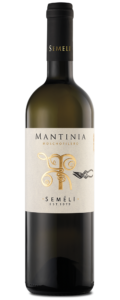
Produced from 100% Moschofilero (say MOSS-coe-FEE-leh-row) grapes grown in vineyards in the Mantinia region at an altitude of 2,100 feet. The grapes were given a slow fermentation at a steady temperature of 60 – 62 degrees Fahrenheit.
In the glass, this wine is bright with a yellow-green color. The aromas are enticing, floral aromas of lemon, citrus and rose petals – the typical profile of Moschofilero. Rich and fruity on the palate, with a long aromatic aftertaste.
Serve with seafood, shellfish and fish in lemon sauces, as well as with Asian specialties. Picture a meal served sea-side fresh from the fishing boats, then grilled or deep fried and served with a squeeze of lemon and you’ve got the spirit behind the perfect pairing for this wine. Serve at 45 – 50 degrees – easily attained by pulling from the fridge about 20 minutes prior to serving.
The Winery
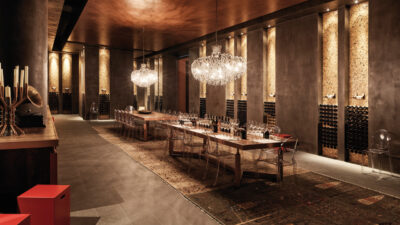
The private tasting room at Semeli winery, Greece.
A very young winery by Grecian standards, where winemaking history is measured in thousand-year increments!
Semeli was founded in 1979 to focus on high-quality wines produced using responsible, sustainable farming. To achieve this objective, Semeli believes such wines begin with ‘terroir’ – a broad term covering everything from their gentle Mediterranean climate to their soils and their selected varieties and vineyard and winemaking practices.
Semeli Winery is located at a high altitude where low-yielding vineyards are planted on the slopes of the Koutsi region, one of the most celebrated “crus” of Nemea. Here, crop levels are low so the resulting concentration of flavor is high and the wines are known for their nice balance between ripe fruit and natural lip-smacking acidity. Their ultra-modern winemaking facility also houses several guest rooms and hospitality centers (see photo) which beckons to well-heeled wine lovers from around the globe!
———————– (“6-bottle” Membership Option: all of above, plus…) ———————–
4. Alleno-Charpoutier CdR, $20
The Wine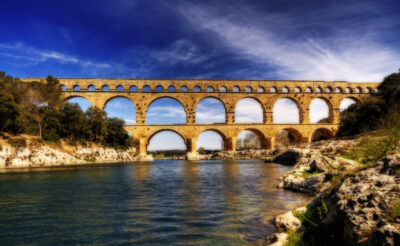
This wine comes from a carefully selected single vineyard located between Avignon, the city of the Popes (and the heart of Chateauneuf du Pape – ‘the New Chateau of the Pope’), and the Pont du Gard, the famous Roman aqueduct as tall as a modern skyscraper (see image).
The vineyard’s terraces are covered with pebbles on sandy or marl soil, which gets a reddish tint from the region’s naturally occurring iron oxide (an old abandoned mine for ochre – a pigment made up of iron oxide and sand/clay – is also nearby, interestingly enough!)
The wine is a blend of Grenache and Syrah (90% / 10%). The grapes are machine-harvested during the cool, early-morning hours to reduce oxidation risk and to preserve the natural acidity that keeps this wine refreshing rather than flabby. Vinification takes place in concrete tanks with a 48-hour cold maceration prior to fermentation, a step which brings out nuanced, high-toned expressions of the grapes. During alcoholic fermentation a ‘rack and return’ process is followed by a gentle extraction during the 4-week maceration phase. The wine is then aged in concrete tanks for nine to twelve months prior to bottling.
Tasting Notes: Deep and bright ruby red in the glass, with an intense nose showing red fruit notes as well as the classic ‘garrigue’ (dried herb notes) of the region mingling with sweet spicy fragrances. On the palate the wine expresses the subtle alliance of aromatic power and tannic finesse. The finish is explosive with exceptional length featuring the spice notes enhanced by hints of licorice.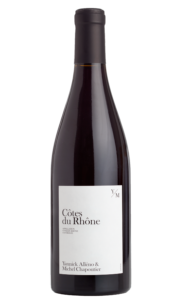
Pair this wine with a cheeseburger made with smoked gouda, chicken roasted with artichokes and potatoes or with the classic pub dish – cottage pie.
The Winery
Yannick Alleno and Michel Chapoutier are two passionate creators with strong characters, bound together by a shared language: the quest for ever-better wines that express a unique sense of place.
In this effort, Yannick Alléno, a 3 Michelin-starred chef and dedicated perfectionist, joined forces with Michel Chapoutier, an innovative and committed winemaker. They both embrace a deep passion for the Rhône Valley.
5. Domaine Lavau Rasteau 2019. $21
The Wine
Along with Gigondas and Vacqueyras, Rasteau is one of the satellite regions surrounding Chateauneuf du Pape. To say it rides on the coattails of CdP is both fair and misleading, as Rasteau produces enjoyable wines at far more affordable prices!
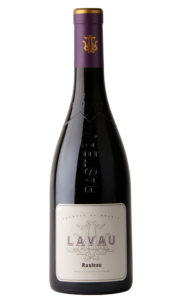 A blend of Grenache and Syrah (50/50), the grapes are destemmed and placed in vats under precise temperature control for a 25-day maceration on the skins prior to fermentation. Once fermentation is complete the wine is transferred to barrels for a 12-month aging period, with half going into large nearly-neutral 450L barrels that have been used for aging one or two prior vintages.
A blend of Grenache and Syrah (50/50), the grapes are destemmed and placed in vats under precise temperature control for a 25-day maceration on the skins prior to fermentation. Once fermentation is complete the wine is transferred to barrels for a 12-month aging period, with half going into large nearly-neutral 450L barrels that have been used for aging one or two prior vintages.
Tasting Notes: The wine features a nose loaded with garrigue scrubland (scents of dried herbs with a unique eucalyptus/menthol-like note), sweet spices and ripe fruit. On the palate, this wine is intense and powerful, well-balanced with long-lingering aromas.
The Winery
Maison Lavau was founded in 1965 in the Rhone Valley but, like so many old world wineries taken over by a younger generation, started growing much more strategically in 2000 when Frédéric and Benoît Lavau took over.
In 2013, they merged with Château Maucoil, emphasizing their commitment to quality wines showcasing the region’s distinct character. Today, Lavau is one of the region’s few remaining family-run estates.
Their grapes from the Rasteau appellation are sourced from plots situated near the village of Rasteau, from hillside vineyards that face east and are covered in alluvial stones deposited there millions of years ago. The Grenache and Syrah vines are cultivated on moderately deep, dry, pebbly terrain, leading to reduced yields and a longer ripening period, allowing for full phenolic development without excessive sugary ripeness in the fruit.
6. Due Terre Cataratto. $20
The Wine
Catarratto is one of the most important indigenous grapes from the island of Sicily and the most widely planted. It is used in nearly every white blend on the island and produces a consistent, quaffable wine that tends to disappear rather quickly. Fortunately, it’s priced affordably enough so opening another bottle doesn’t break the bank!
Due Terre uses the less common biotype called Catarratto Bianco Lucido which is known for making higher quality, elegant wines that are more complex than most Cataratto wines, you’ll find this wine to be full of juicy acidity with a pleasant minerality. The north and east facing vineyards on Monte Bonifato are over 650m above sea level on pure calcareous rock with a very thin, poor topsoil.
This wine shows classic notes of tropical fruits and a hint of bitter almond that keeps one’s interest once the fruit has made its initial impression. It is 100% Cataratto Bianco Lucido, weighing in at a lightweight 13%.
The Winery
Due Terre Wines is a collaborative effort between friends. This tiny enterprise makes wines from the indigenous grapes of Sicily and are certified organic – a time-consuming and expensive effort. All their wines are 100% pure varietals and are crafted with minimal intervention in the cellar in order to allow the characteristics of the grape to shine through. Sicily has the largest number of organic vineyards in Italy and produces more grapes of quality than have a home in IGT and DOC bottling.
The labels use drawings of the traditional marionettes used in Orlando Furioso and other plays in the Opera dei Pupi (the roots of which stretch back to at least the 15th century). In Sicily, this form of entertainment uses wooden marionettes on strings and metal wires instead of hand puppets made of cloth. Although the tradition is becoming less common, the Opera dei Pupi has not died out completely and there are now actions being taken to preserve this unique folk art.


